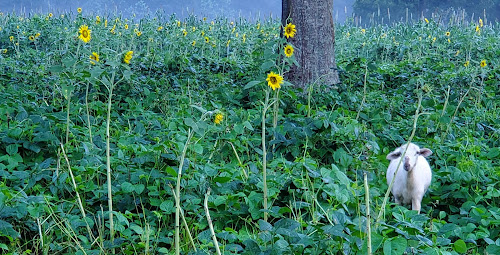I added sunflowers to the mix in two fields: the Coast Electric field and the west blueberry field. Coast Electric field is a new area that we are just getting fenced in and it has very poor soil. In this field everything germinated and has grown minimally well. The sunflowers are flowering at about a foot and a half high.
The growth in the west blueberry field has been phenomenal, with sunflowers flowering at heights of 4, 5 and 6 feet. For years the west blueberry field has been a lambing and sheep wintering area. Sheep being fed hay and grain, sheep camping out, stomping around and pooing everywhere. Except for all the sheep business, I never added any fertilizer or lime to the west blueberry field. In fact it was a rather weedy field with lots of smut grass throughout (as the name implies, a nasty and invasive grass the sheep don't eat) and I didn't mind applying herbicide to the whole field prior to planting. But, the soil in this field must be spectacular and I look at it as an example of what the soil can be like in many of the other fields on the farm, just given the right care. What follow are a series of pictures showing the sunflowers and other forage that grew in the west blueberry field.
I caught this tiger swallowtail butterfly, Papilio glaucus, flying from one sunflower to another.
Jackie caught this spicebush swallowtail butterfly, Papilio troilus, on a sunflower. We see many of this butterflies on the sunflowers as well as the flowers in Joy's garden.
There are a few lambs from the spring lambing with the Georgia rams. We separated them into two groups (ewe lambs and ram lambs) and put them in their own section of cowpeas/sunflower forage. They are not as voracious as the moms, that flock of 220 ewes strips all the leaves off a half acre of cowpeas 2 to 3-foot tall within a few hours. The number of lambs is such that cowpeas have time to regrow. However, the lambs like the sunflower leaves the best, I think, striping them off the stalk as high as they can reach.
A ram lamb in the cowpeas with sunflowers.
Some of the ram lambs eating some supplemental grain. I feed them just a little to get them in the habit of coming up where I can check on them.
The ewe lambs.































